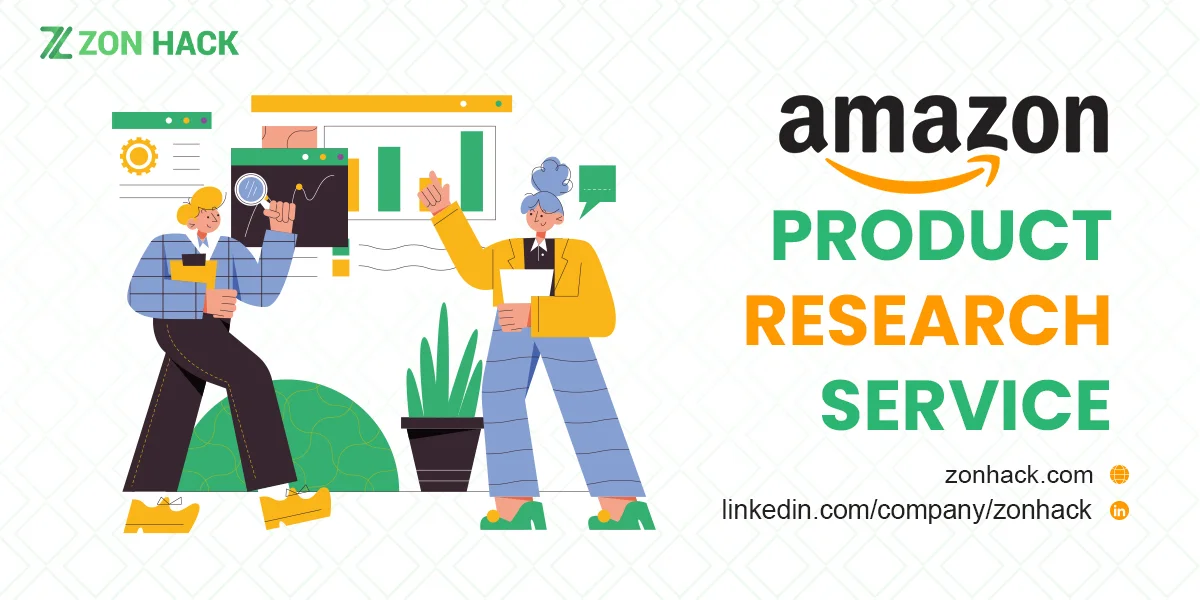It is impossible to sideline the importance of market evaluation. Technically, to become a successful Amazon seller, one needs to evaluate the market. In essence, it is essential to conduct proper Amazon product research before deep-diving into selling on Amazon. Thankfully, the process of choosing a sellable product isn’t as overwhelming as it is pictured.
At Zon Hack, we have helped several new sellers scale their business on Amazon by identifying the right product they can sell in the marketplace. Typically, sellers must examine plenty of things when conducting product research on Amazon. This includes brand restrictions, niche selection, selling fees, competition level, etc.
However, there have been paradigm shifts in how products are being researched on Amazon, particularly in the past few years. This explains why some things that used to work before may not be valid at the moment. You can use the Zon Hack Amazon product research service to stay abreast of the best research practices to help you find the perfect product to sell on Amazon!
Albeit, this article comprehensively explores pragmatic tips and information to help you with your Amazon product research.
Firstly, what Is Amazon Product Research?
In the simplest of terms, Amazon Product Research is the process of analyzing the Amazon market trends for products that have a high potential to generate massive sales. The central idea of conducting product research on Amazon is to identify products that you can cheaply purchase and sell at competitive prices, helping you enjoy great profit margins.
Importance of Doing A Product Research?
The most vital and paramount step to beginning your journey as an Amazon seller is finding the best sellable products. Surprisingly, several persons who use Amazon FBA do not consider conducting product research until they start experiencing lesser demand, lower competition, and ultimately, low sales.
As mentioned in the introductory section of this article, Amazon has grown past the era where simply using a nice logo and custom packaging works “magic.” The stringent Amazon selling policies and the rapidly increasing numbers of sellers champion the importance of understanding that these old ways of finding the right product to sell on Amazon don’t work anymore.
First, you need to have a list of Amazon’s bestselling products that you desire to sell. Afterward, do a detailed analysis to identify the sales volume of such a product’s market. This is essential because you won’t want to sell items that buyers aren’t searching for.
The next section of this article comprehensively explores the best and most up-to-date ways of conducting product research on Amazon.
How to Conduct A Product Research on Amazon?
Typically, you can conduct Amazon product research in two broad ways:
- Manually
- Using Automated Tools
Let’s deep dive into each of these research methods.
1. The Manual Research Method
Manually doing product research on Amazon has proven to be a considerably effective method, particularly for newbie sellers with SEO knowledge. While it may be relatively time-consuming, Amazon has provided itself as an excellent resource to make the process easier for sellers. The manual Amazon product research method includes doing the following steps:
i. Examine the Amazon Bestsellers List
Amazon’s Bestsellers page helps a great deal in researching a product. This should be your first approach to Amazon Product research, as Amazon displays all the bestselling and top-performing items in this section.
On the Bestsellers page, you can filter your search options using categories and sub-categories. The Bestsellers lists help you identify products with high sales volume, influencing the eventual niche you will venture into.
The information gotten on this page can be used to accurately predict products that will appeal the most to your target audience, develop a solid strategy to aid your business expansion, and so on.
Ensure you choose items that neither priced too low nor too high. Also, products with limited competition have better prospects to sell in this marketplace. However, ensure the lower competition is accompanied by high product demand; otherwise, you might be risking selling a “dead” product. In essence, a product that nobody’s searching for.
ii. See what your competitors are doing.
Secondly, analyze the sales strategy that your competitors are executing. Identify how they are selling their products. You can also get this information via the proper examination and analysis of the Amazon Bestsellers page. This insight helps you to know the products that are selling the most, the products with the best ratings, and customer feedback.
Besides, you can check out other sellers of the same product you are choosing outside Amazon. You can utilize popular search engines in this regard. Pinterest is also an excellent resource.
Another smart strategy is buying your competitor’s product and examining their service delivery. This way, you can learn from their best practices and identify business approaches you should avoid. This gives you an edge over competitors when selling your products.
Other tips on how to conduct Amazon Product Research manually
After checking to analyze the Amazon Bestseller page, and identify what your competitors are doing, you can also consider doing the following to get better and more comprehensive insights:
- Explore retail stores
- Explore Shopify stores
- Analyze the eBay trending list
- Check out Amazon storefronts
- Check out products on Pinterest
- Check the “Customers Also Bought” section on Amazon.
- Explore sponsored product posts.
2. The Automatic Way to DO Amazon Product Research
This is seemingly the quickest and most straightforward way of conducting product research on Amazon. It saves time and comes in handy!
Without gainsaying, examining the top-selling products, and analyzing product images, descriptions, listings, and competition via Amazon’s bestsellers list, as explained above, can be quite tasking and time-consuming. However, checking if a product has high demand and is easily sellable on Amazon is a crucial task that you cannot afford to sideline. You also need to identify if such a product is seasonal, shipping feeds, return policy and refund rate, and many other factors that are worthy of consideration.
Unfortunately, you can do all of these, visit plenty of websites and eCommerce stores, examine potential products, consider pricing, seasonality, and other criteria discussed above, visit competitors, and even buy your competitor’s product without still getting a perfect lead on the best product you can sell on Amazon. It is possible to spend several hours switching through tabs, expending energy, without coming up with any product idea.
Thankfully, Zon Hack is here to the rescue! Our Amazon Product Research service is conducted by research experts, helping you identify the best products that you can sell on Amazon. Don’t hesitate to visit our “Contact Us” page to speak with us!
Similarly, we also offer unconventional tips, assisting you to do Amazon product research on your own with real-time data. We provide powerful Amazon data, helping you identify unlimited possibilities for your product research on Amazon.
Below are further tips to curate product ideas on Amazon without having to seek inspiration elsewhere. We explore these steps too when helping you conduct your Amazon Product Research:
i. The 999 Demand-Finding Method
Undoubtedly, various expert product research methods are available; nonetheless, the 999 method is arguably the most popular. This method helps you to discover the number of items in a seller’s FBA inventory and how many of them he sells daily.
Follow the steps below to get it done:
- Visit the product’s page on Amazon
- Add the product to the cart.
- In your shopping cart, edit the quantity to 10+
- Type the highest number permitted, 999, and click “update.”
- If the seller you are analyzing has less than 999 products in his inventory, Amazon will let you know the exact number of stocks remaining: “This seller has only ** of these available.”
- Do this daily for one week.
- The difference in inventory stocks daily reveals how fast such a product is selling daily.
However, you need to understand that Amazon has several sellers; hence, the chances of multiple sellers selling a particular product are exceedingly high. Therefore, you may need to do this analysis for all these sellers to get the exact data you seek. Unfortunately, this method may become obsolete and useless if a seller has restricted the number of products each user can purchase. Also, the 999 method may be ineffective during inventory updates.
ii. Current list optimization
This method comes in handy when the products on the first page have poor listings. Optimizing your listing positions you to outrank and outsell such products if they are in high demand presently.
Generally, this infers that the competition must be relatively weaker, making it easier to reach the first page even if you have very close competitors. Optimizing your listing may require some SEO expertise – you can trust the experts at Zon Hack to handle the process for you.
Technically, sellers that use Amazon FBA have poor listings because of the following reasons:
- Poor product image quality.
- Nondescriptive or short titles.
- Some sellers do not upload product images (sometimes just one).
- Omission of important information
iii. New Arrivals
Identify top-selling newly released products on Amazon. The New Arrivals section on Amazon is ranked based on how products are rapidly selling, despite their recent launching. For instance, products like eclipse sunglasses were in high demand sometime in July 2020 due to the predicted solar eclipse event happening on August 21, 2020, in the USA. Identifying such new arrivals and joining the trend is a profitable way of making money on Amazon.
iv. Trending Products
New or old, Amazon trending products feature products that are top and hot. These products are the bestsellers in their respective categories, having exceedingly high demands from customers. A top trending product in the babies’ category is the bathing tub (check it out). Bathing tubs are highly demanded throughout the year – you can create related accessories to this product!
v. Most Wished Products
Is there any category that catches your interest? Ensure you find the most wished and most gifted products in this category. Products that are highly wished and gifted technically have high demands and are also heavily searched. Examining this list is a time-saving technique to find interesting products that you can sell while conducting Amazon product research.
The most wished products list features awesome products with relatively low competition, high demand, and excellent profit margins, especially during holiday periods. A perfect example is the essential oil diffuser; this product was one of the most gifted products during the prime day! Explore the most wished and most gifted Amazon list in preparation for the upcoming holiday season!
vi. Track Successful Sellers’ Products
Above everything, Zon Hack can help you track several other successful Amazon FBA sellers and their listings. The data provided enables you to gain detailed insights on new products that such sellers are listing, influencing your decision to choose the right product to sell on the marketplace.
Things to Avoid While Conducting an Amazon Product Research
Outlined below are the major mistakes that most Amazon FBA sellers make while conducting Amazon product research. While this may appear as a popular trend, it is advisable to avoid them as much as possible.
i. Choose very small niches.
The more active a market is, the better your chances of making more sales. In essence, the higher the market volatility, the better the sales. An active market is a busy market, experiencing a high influx and efflux of customers, high search volume, and sales volume. Excessively narrowing your niche does more harm than the intended good, especially in certain obscure categories.
ii. Pricing your products extremely low.
Some sellers think reducing the price of their products gives them an edge over their competitors. Why this isn’t entirely false, pricing your products extremely low is highly detrimental both to you and your profit margin. The significant harm you are doing to yourself is sabotaging your income.
Technically, you should never base your product price on the prices of your customers. You should chiefly consider several other factors instead, including profit margin, Amazon fees, sourcing costs, and a few others.
If you price your products “too” low, you may risk relegating your products and seller to the “low cost” and “low quality” quadrant.
Other mistakes you should avoid are:
- Sales of undifferentiated products
- Failure to calculate profit margins.
- Inability to improve your product




